Week 4: Echinoderms
1/70
There's no tags or description
Looks like no tags are added yet.
Name | Mastery | Learn | Test | Matching | Spaced |
|---|
No study sessions yet.
71 Terms
How many species of echinoderms are there?
7300 extant species
15,000 fossil species
What characteristic of echinoderms is different to any other invertebrate group?
all marine
Where do echinoderms live?
shallow + deep water
adults mostly benthic - don’t swim with a few exceptions
sessile, embedded in mud as suspension feeder
larvae pelagic
constitute 95% of biomass in deep ocean → cosmopolitan in deep ocean
Echinoderms diverse lifestyles
predators
detritus feeders (dead organic matter)
filter-feeders
scrape algae from rocks
What clades is the phylum Echinodermata in?
Echinoderms are bilaterians despite pentaradial symmetry
They are also deuterostomes
A part of ambulacraria with hemichordates
sister group to chordates
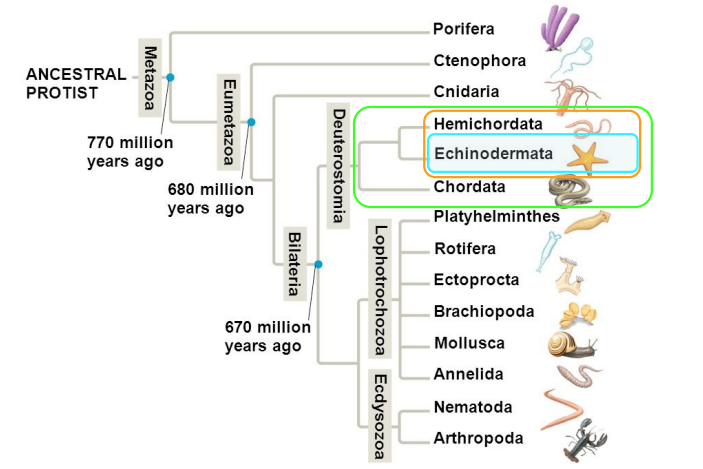
Characteristics of Deuterostomes + Echinoderms
Deuterostoma | Echinodermata |
Bilateral symmetry | Secondary pentraradiate symmetry |
Complete gut | yes |
Coelomates | yes |
Gill slits | lack of gill slits (some fossils do have primordial gill slits)→ lost in modern Echinoderms |
Post anal appendage (tail) | lack (some fossils do have it) |
What is a coelom?
body cavity
similar to a peritoneum in humans
When did modern echinoderms with mineralised skeletons arise?
present in the early Cambrian (543-490 Mya)
Molecular data strongly support Deuterostomia clade
only ~5000 genes in common with protostomes (D.melanogaster and C. elegans)
Materna et al., Dev Biol. 2006
using Reciprocal BLAST - basic local alignment tool → uses an algorithm to find parts in common
Ambulacra
holes where tube feet get out
Echinodermata systematics
5 major classes of echinoderms
Pelmatozoa (Crinoidea)= outgroup of all other classes
This is not disputed→ positions based on fossil record and some molecular data
Evidence
Position based on fossil record and some molecular data (18S and 28S, Littlewood et al. 1997)
Development and other characters (Swalla and Smith, 2006)
Two hypothesis on how Eleutherozoa are related: Asterozoan vs. Cryptosyringid hypothesis
Asterozoan hypothesis
proposes that sea stars (Asteroidea) and brittle stars (Ophiuroidea) are sister groups, forming a clade called Asterozoa, within the broader group of echinoderms
Cryptosyringid hypothesis
suggests ophiuroids are more closely related to sea urchins and sea cucumbers, forming the clade Cryptosyringida
asteroidea as an outgroup
Asterozoan vs. Cryptosyringid hypothesis
Phylogenomic studies supports Asterozoa clade (starfish and brittle stars as a group together)
Telford et al 2014 → study comprises 219 genes from all echinoderm classes
Echinoderm fossil record
only 5 crown groups
many species completely extinct
end Permian mass extinction → bottleneck seen in surviving animals→ only 5 classes we have survived
excellent fossil record due to mineralised skeleton
entire rock formations made of echinoderm fossils in Carboniferous and Jurassic
encrinite = rock made of crinoids
Symmetry in echinoderms
pentaradial symmetry
evolved from triradiate and (Helicoplacoids) and bilateral (cinctans, solutes) forms
Calcitic Skeleton
composed of ossicles called stereom
endoskeleton (not a shell→ different to molluscs)
endoskeleton arising from mesodermal tissues and covered by epidermis + grows internally
cells reside in the holes and secrete the skeleton
stereom like a single calcite crystal (CaCO3 + 5% of MgCO3) → percentage of MgCO3 depends on where the animal lives
The pores are populated by dermal cells and fibers (stroma).
0.1% organic matrix protein.
Birefringent optical properties.
embedded in soft tissues or fused together
Birefringent optical properties of ossicles
double refraction of light
Pentaradial body organisation in adults
Central disc and five set of body parts.
made by 5 radii - bifurcated/ branched
Five-fold organization of skeleton and most organ systems
Unique motility despite the radial symmetry→ directional movement
Body orientation: Madreporite (opening of water vascular system) and radii.
Orientation of features of body plan
Ambulacral A = opposite to Madreporite
top - aboral → opposite to mouth
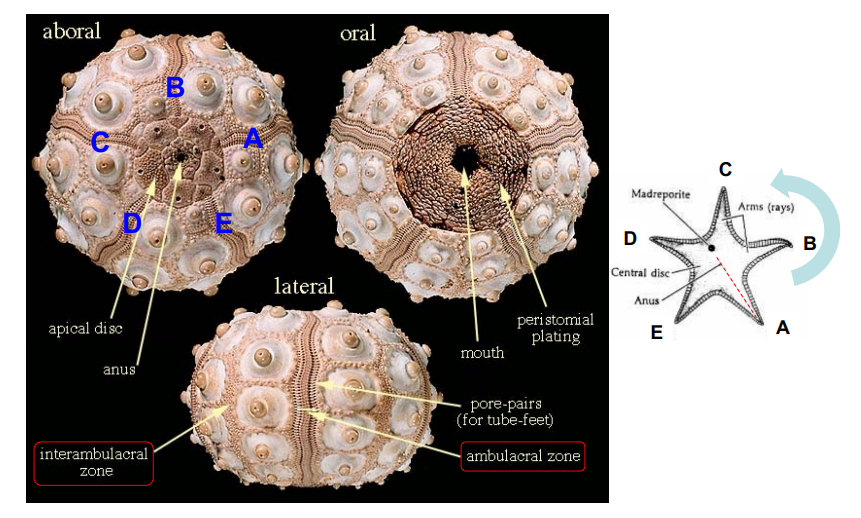
Functions of the water vascular system
locomotion, respiration, feeding, sensory perception- can function as a hydrostatic skeleton
Is the water in echinoderms affected by its surroundings?
liquid in water vascular system is in equilibrium with sea water (not that it is sea water) i.e if salinity of seawater changes, as does the salinity of water in the system
Features of a water vascular system
Fluid-filled canals branching from a ring canal.
The canals lead to podia (tube feet) arranged along branches (ambulacra)
Tube feet are sucker-like appendages
Tube feet are extended and retracted by hydraulic pressure
Embryological origin from coelom (left mesocoel)
Fluid similar to sea water and cells (coelomocytes) circulated by cilia
stone canal = completely sclerotized

Madreporite
also called a sieve plate
in communication with external part
Sea Urchin Water Vascular System
tube feet→ movement/ attachment to substrate
movement by hydrostatic pressure
extension of tube foot → muscle contraction
thousands of tube feet can be coordinated for movement

Hemal and excretory system
Derived from coelom.
Fluid moved by cilia and muscle pumping.
Oral and aboral ring connected by axial sinus.
Axial gland which produces some coelomocytes.
Extend to the gonads.
Gas exchange occurs in the dermal gills or papullae.
Excretion and ions exchange through podia and papullae.
Epithelia super-ciliated → cilia allows water circulation (like how we have hearts)
Hemal system more linked to immunology
^ runs next to stone canal
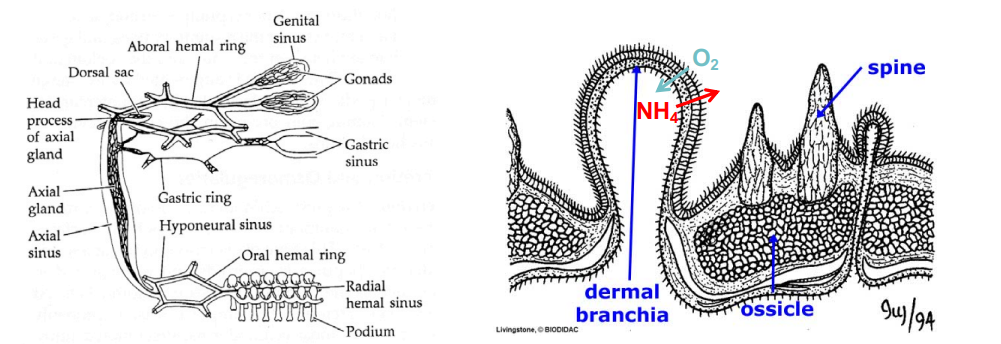
Nervous System
NS organised with pentaradial symmetry
no clear anteroposterior axis
lack of cephalisation - cephalisation = common of bilaterians
Central (CNS) and peripheral (PNS) nervous system
Radial nerve cords (RN) run under each of the ambulacra (cell bodies of motor neurons and interneurons) (nerve cord = like our spinal cord)
A nerve ring (NR) connects the radial nerves.
Radial nerve cord underneath water vascular system
Radial nerve cord has a system similar to our spinal cord → interneurons, neuron junctions etc.
Sensory Organs
Sensory neurons respond to touch, chemicals, light and water current.
Located primarily within the ectoderm of podia and send axons to the radial nerves. Mostly a nerve-net.
No centralized sensory organ
Diffuse light sensing
Skeleton important part of the visual system→ skeleton that forms as a lens
tube feet essential for light sensing → have photoreceptors (sea urchins → Ullrich-Lüter et al 2011)
‘eye’ at end of arms
Pedicellariae
Pincer-like structure produced by the skeleton
Responds to stimuli independently of main nervous system
Neuromuscular reflex
Defense, predation, hold object for camouflage
have different forms
aboral side- exposed to outside world
suicidal? structures → some contain venom
Reproduction and Life Cycle
No sexual dimorphism
Separate sexes → very rarely are they hermaphrodites
External fertilization → shed (many) gametes in water column
Synchronize the reproductive activities
Indirect development.
Bilaterally symmetric ciliated larva (pluteus, dipleura etc.)
rapid development
larvae part of zooplankton
How long does the larvae state last in echinoderms?
tropical water species can have adult in a few weeks
temperate areas → larvae state can in the ocean for a year → can divide and produce more larvae (asexual reproduction)
What happens to the bilateral symmetry of larvae?
young adult emerged only from left rudiment (part) of larvae → changes the axis
Sea Urchin Development
radial cleavage
first opening = anus
second = mouth
larvae= bilateral symmetry
Only left coelum → adult (in outgroup Hemichordates- adult from both left and right)
Left and right plane of symmetry changes due to this→ new body plan
Rapid metamorphosis

Metamorphosis in sand dollar, Dendraster excentricus
develop inside -out
absorbs larva
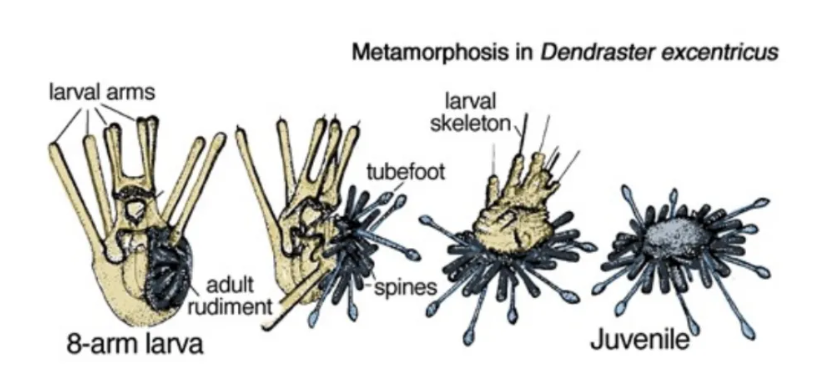
What differs the 5 classes of echinoderms?
Orientation to the substrate and disposition of ambulacrial surface
where the ambulacra (where tube feet get out) is in relation to the substrate defines each class
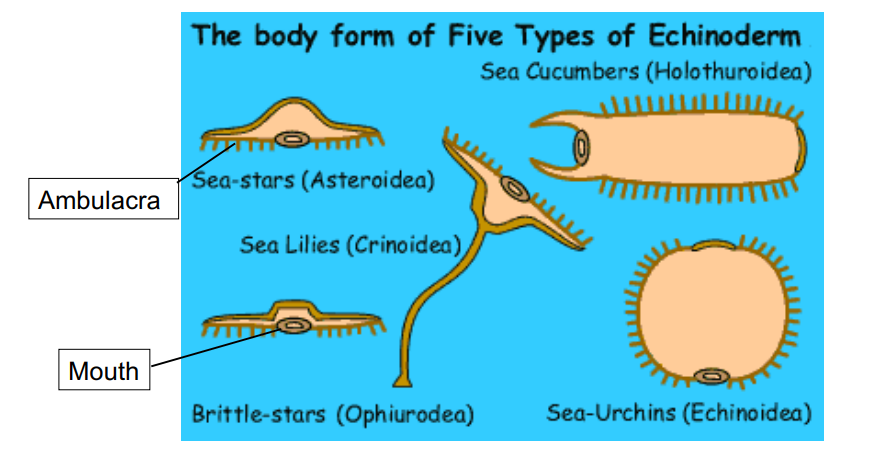
What animals are crinoids?
Sea lilies and feather-stars
Features of stalked crinoids
mostly live in the deep ocean (more than 500 m below sea level) attached to the bottom
Living fossils.
All crinoids are passive suspension feeders.
Direct development.
U-shaped gut - mouth and anus on same surface

Pelmatozoa
crinoidea
Eleutherozoa
asteroidea
ophiuroidea
holothuroidea
echinoidea
Crinoidea fossil record
Most abundant and important of fossils of Paleozoic and Mesozoic.
5000 fossil species.
85% of extant crinoids (540 species) are unstalked feather stars → probably just a small percentage of reality
From Articulata
modern sea lilies from bottleneck at end-Permian
Crinoids divided into stalked and un-stalked
diversity drop (ME) across Permian Triassic boundary
mostly sessile crinoids in the past
now can attach to substrate + release themselves
Anatomy of stalked crinoids
Cuplike body bearing five usually branched and commonly featherlike arms → helps with suspension feeding
Stalk made of discoidal skeletal pieces columnal. Central canal containing coelomic and neural tissue.
Small side branch (pinnule) on alternating sides of successive ossicles along the arms.
Comatulida have hook-like cirri.
Comatulidae is the most common and the only shallow water
Modern comatulids reduced the stalk
stalk can be re-absorbed - holding apparatus - cirri
arms are mobile - contain ossicles and muscles
crinoids can swim by moving arms different directions

How many extant sea stars are there?
1600
Features of Asteroids
Central disc and multiple (typically 5) radiating arms.
No sharp demarcation between arms and central body → sometimes can’t identify arms
Extension of a large coelomic cavity from the central disc into the arms (the gonads and pyloric caeca).
Move using tube feet.
Most are predators. Feed on sessile/ benthic or slow-moving prey (e.g. mollusks, corals).
Many are able to extrude their stomachs out and digest food outside of the body→ digestion in situ
problem for coral reefs
when sea stars metamorphose they have 5 arms - then they can branch into more or more are developed- arms can change after regeneration→ still pentaradial
Asteroid phylogeny
still no clear understanding on how the families relate to each other→ species + family phylogeny not well resolved
new phylogenies every year show different relationships
problematic - hard to identify appearance/ disappearance of important characters without phylogeny
What animals are ophiuroids?
brittle stars
basket stars
Features of ophiuroids
Ophiuroids rapidly fall to pieces after death, and are rarely preserved whole (i.e brittle) → arm ossicles just attached by muscles
^ slightly worse fossil record/ less articulated fossil record
Five long, flexible arms and a central, armored, disk-shaped body, up to 60 cm- strong demarcation of central disc from arms
Arms do not have gonads, no stomachs
Basket stars arms are very highly forked and branched.
Dominant in many parts of the deep sea.
Are scavengers and detritus feeders, prey on small live animals such as small crustaceans and worms, filter-feed on plankton with their arms (basket stars)
move very fast
Anatomy of ophiuroids
The disk contains all of the viscera.
Calcite ossicles are fused to form armor plates, tests.
Gas exchange and excretion occur through cilia-lined sacs called bursae.
Move rapidly by wriggling their arms.
The arms are supported by an internal skeleton plates that look like vertebrae (vertebral ossicles) - resemble our vertebrates- convergent evolution - allows for freedom of movement
These are moved by a system of muscles and linked together by ball and-socket joints.
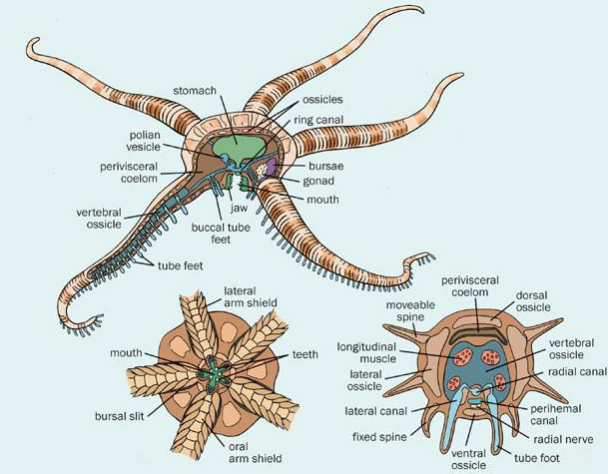
Bursa- ophiuroids
out pocket of skin
gas exchange organ - different to starfish
Bursa lined with cilia
In the bursa- opening of the gonad
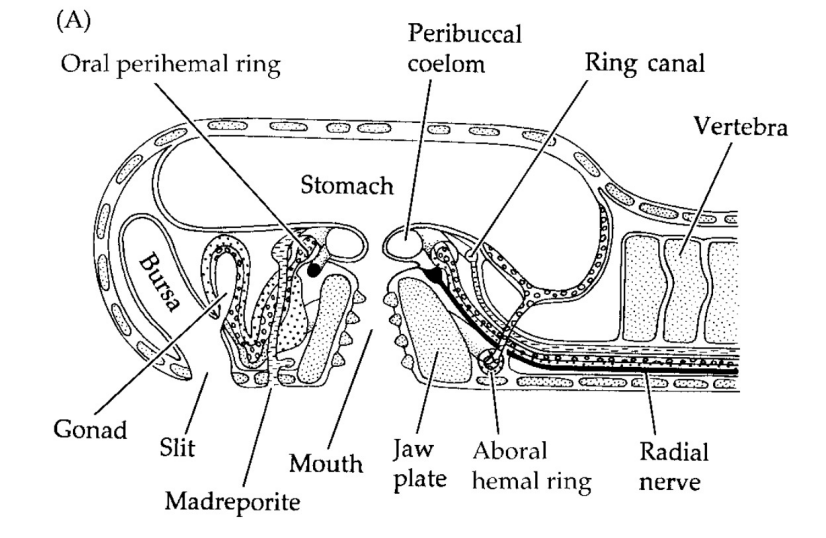
What is unique about ophiuroid offspring?
ophiuroids produce fewer offspring but offspring produced are adults
Which animals are echinoids?
sea urchins
pencil urchins
sand dollars
heart urchins
How many species of echinoids are there?
940
How many species of ophiuroids are there?
1600 species
When did echinoids first appear
in the Ordovician (~450 Mya)
Features of echinoids
Regular echinoids, with nearly perfect pentameral (five-fold) symmetry; and irregular echinoids with altered symmetry (secondary bilateral)
Skeleton is almost always made up of tightly interlocking plates that form a rigid structure or test
Covered with movable spines
tube feet made of soft tissue so is degraded quite quickly → just holes left
What is unique about sand dollars?
the mouth is at the surface but the anus is lateral
What is unique about pencil sea urchins
spines remain when they die- in regular sea urchins they are movable
Echinoid anatomy
Five conspicuous gonads arrayed interambulacrally
Mainly herbivores (algae), but can graze on anything: plant, animal, rock
Parallel to the intestine is the siphon
Only soft part of skeleton is the peristomial membrane
Unique jaw apparatus known as Aristotle's Lantern that can protrude from the mouth.

Aristotle’s Lantern
A lantern is composed of:
five pyramids in the interambulacral space
each pyramid is formed of two hemi-pyramids which support an elongate tooth.
Five teeth constantly growing (like rodent teeth!)
A number of smaller structures (Epiphysis) and muscle
tooth attached to muscles
peristomal membrane = only soft part of the animal
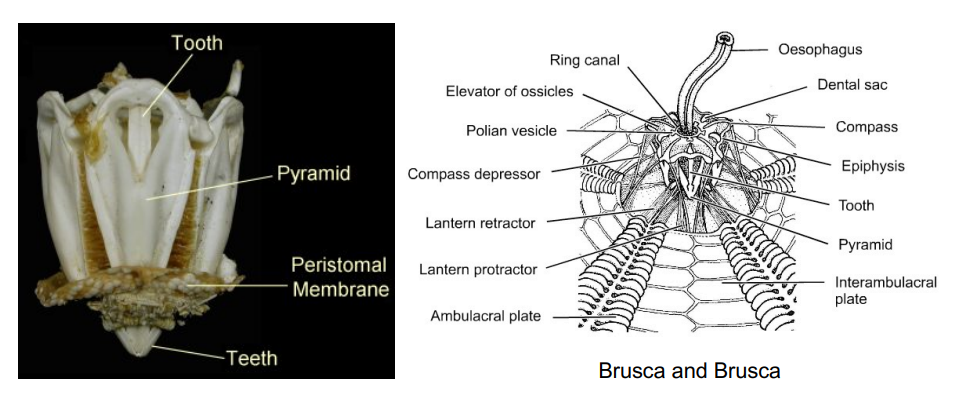
Irregular echinoids
Includes sand dollars and sea potatoes (heart urchins)
Secondary plane of bilateral symmetry
Anus has migrated in evolution such that anterior posterior axis is oriented parallel to the ground
Which animals are holothuroids?
sea cucumbers
How many species of holothuroids are there?
1400 species
Features of Holothuroids
The oldest sea cucumber spicules are from the Ordovician (~460 million years ago).
Nearly every marine environment.
Generally long and wormlike.
Five rows of tube feet running from the mouth along the body.
Skeletal plates are reduced to microscopic spicules (softbodied).
Several species can swim
sea cucumbers used in food + pharmaceutical industries → anticoagulant produced by sea cucumbers
Holothuroid Anatomy
Calcareous ring that encircles the pharynx or throat.
This ring serves as an attachment point for muscles.
Circlet of oral tentacles.
Madrepore opens into the coelom.
Respiratory trees used in gas exchange are attached to the rectal area- specialised organ- attached to aboral/ anus → only class with specific gas exchange organ
madreporite mostly internalised but still there
convoluted + well-developed intestine

How did holothurians evolve?
from an echinoid-like ancestor
Echinoderm Regeneration
What can echinoderms regenerate?
Complete regeneration of missing body parts
Regenerate missing limbs, arms, spines - even intestines → matter of days/ weeks months → depends on cold/ warm water
Some brittle stars and sea stars can reproduce asexually by breaking a ray or arm or by deliberately splitting the body in half
Each piece then becomes a whole new animal.
Even the larva has regenerative properties and can reproduce asexually
Regenerate: intestine, skeleton, nervous system, gonads …..
Generation of a wound, attraction of coelomocytes, proliferation, patterning of the new structure.
Defense mechanism: brittle stars + sea stars
can easily break their arms to escape predation (autotomy= self amputation)
Regeneration: sea urchins
regenerate skeleton and pedicellariae (Suicide structures)
Sea cucumber defense mechanism
when attacked they eviscerate the so called Cuvierian threads which are toxic (holothurin)
Sea Urchin Immune System
Recognition of non-self and damage.
Extensive cell-cell communication.
Innate immunity.
Formed by many different cell types (Coelomocytes).
Respond rapidly to pathogen and wound.
Sophisticated repertoire of immune molecules and large. expansion of pathogen recognition molecules. They also have the machinery for adaptive immunity.
EchinochromeA (thought to be related to its ability to scavenge free radicals and reduce oxidative stress), antibacterial.
Hibino et al, 2006
Echinoderm Life Span
Red sea urchin (Strongylocentrotus franciscanus) can live up to 200 years (estimate on the jaws (Ebert 2004)).
No reduction in growth.
No reduction in reproductive capacity (increase!)→ other organisms have peak maximum growth/ reproductive ability
“Negligible senescence” Senescence: change in survival probability, physiological (reproduction capacity), reduced cellular function.
Better maintenance and repair mechanisms, both at cellular and organismal level.